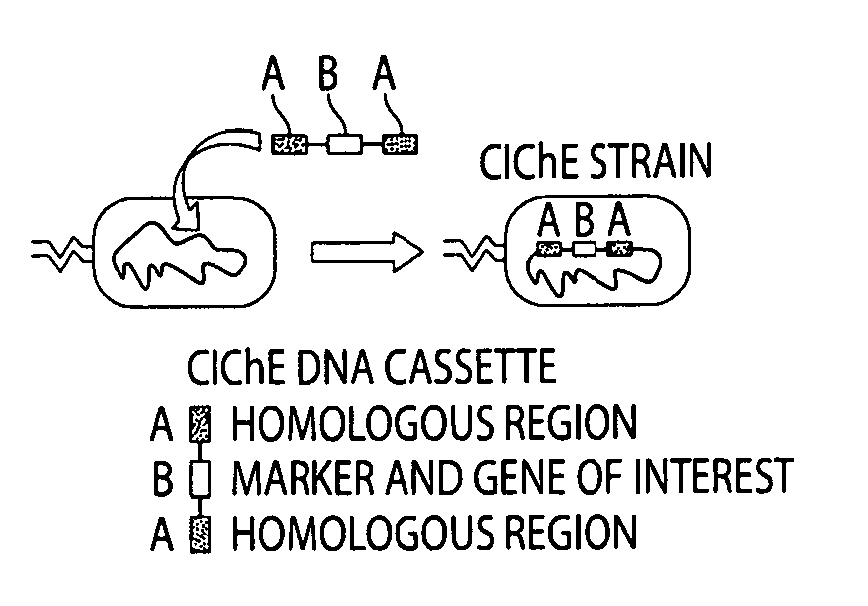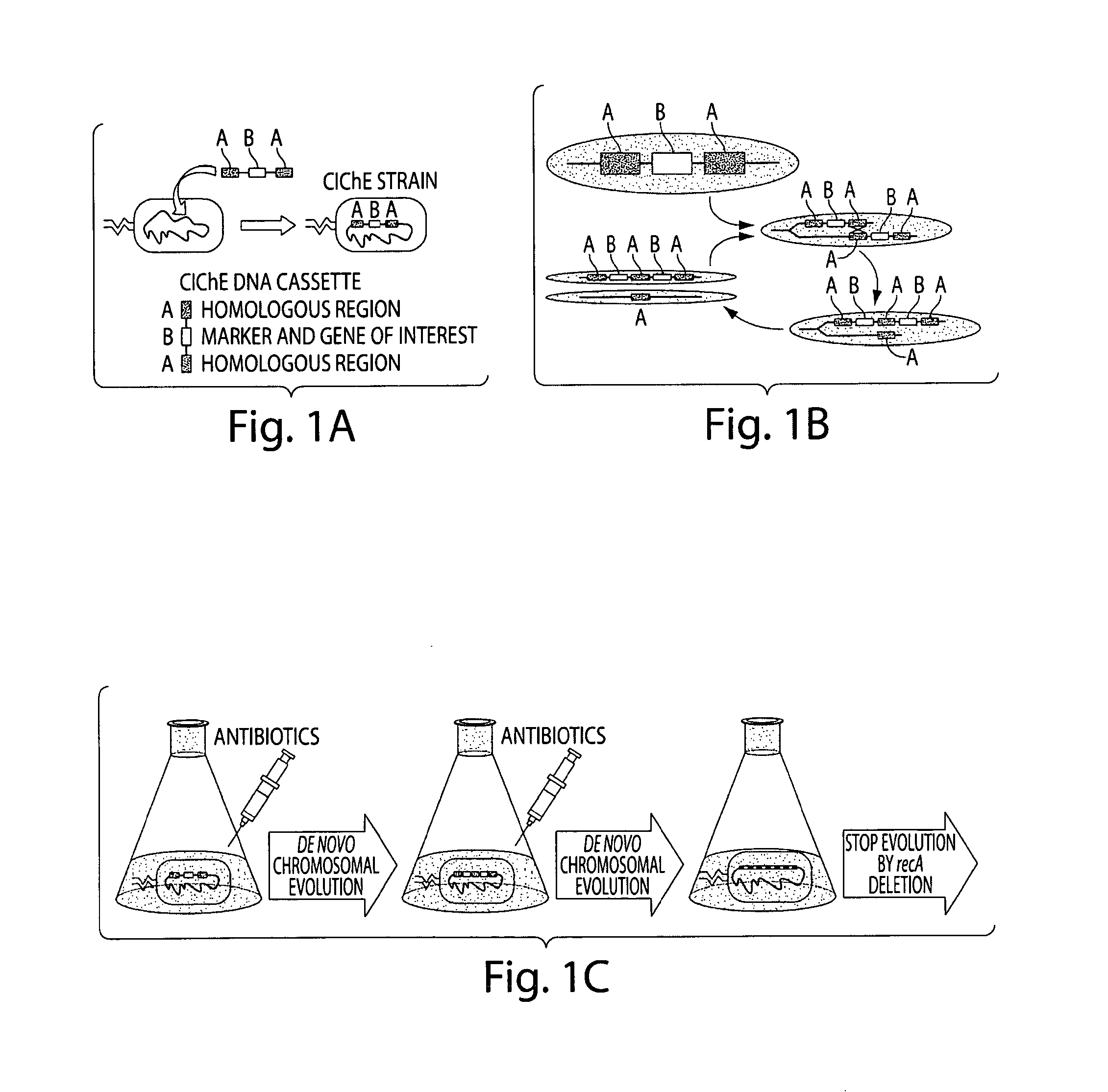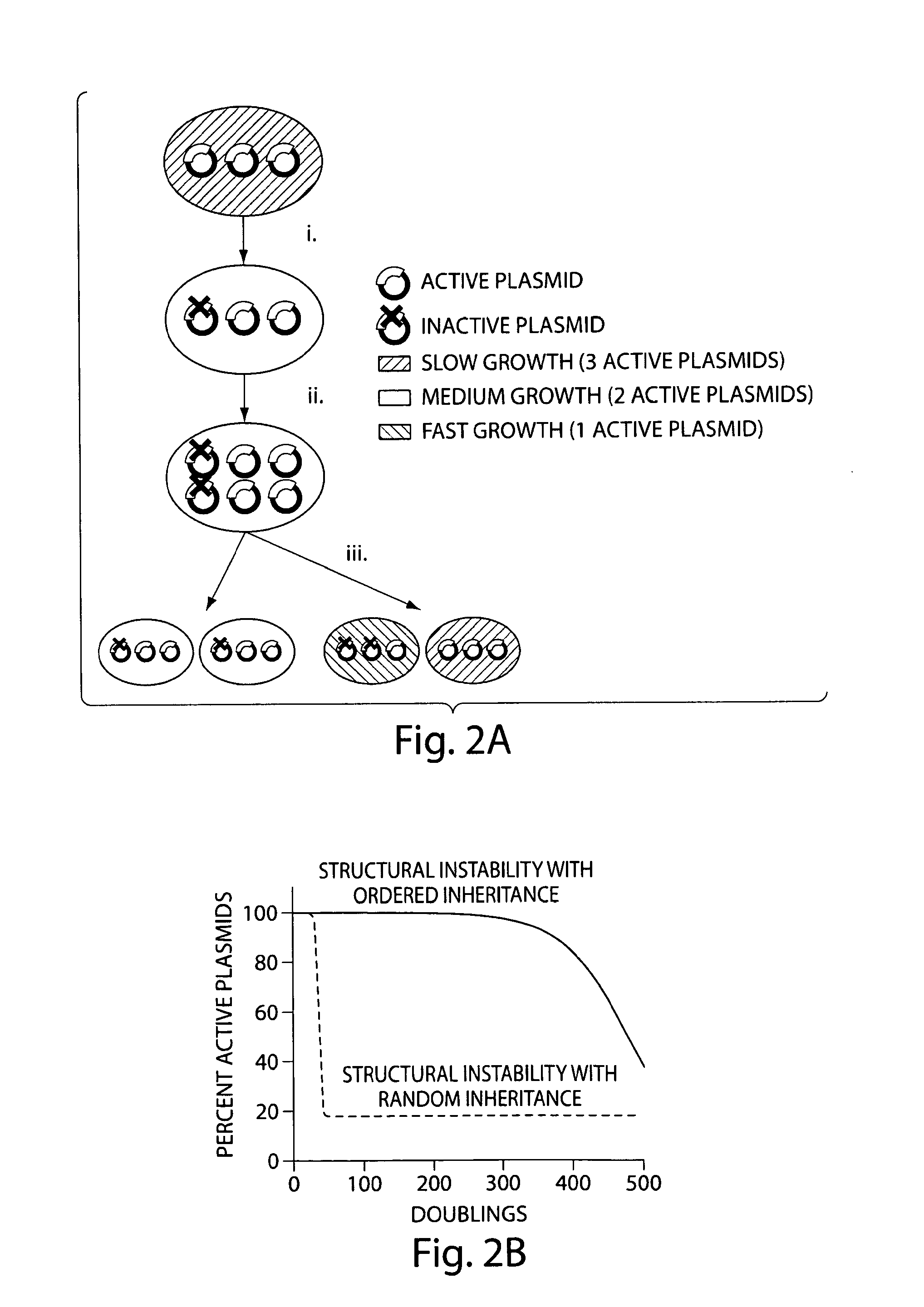Genetically stabilized tandem gene duplication
a tandem gene and gene duplication technology, applied in the field of constructs, can solve the problems of loss of productivity, inability to achieve long-term expression, and fundamental flaws in plasmid propagation, and achieve the effects of extending genetic stability, avoiding allele segregation, and stable protein expression
- Summary
- Abstract
- Description
- Claims
- Application Information
AI Technical Summary
Benefits of technology
Problems solved by technology
Method used
Image
Examples
example 1
Introduction
[0102]TGD was implemented by constructing a DNA cassette containing gene(s) of interest and chloramphenicol acetyl transferase (cat), flanked on both sides by identical, non-coding 1 kb regions of foreign DNA that has low homology to any other region of the E. coli genome. The large identical regions served as homologous substrates for the crossover event, and increasing chloramphenicol concentration was used to select for cells containing duplicated genes. The construct was delivered to a wild type E. coli genome and subcultured in increasing concentrations of chloramphenicol. Once the cells had developed resistance to a particular concentration of chloramphenicol and therefore had reached a desirable number of duplications, recA can be deleted to prevent any further increase or decrease in copy number. After this, the strain expressed the gene(s) according to the gene dosage and did not require chloramphenicol to maintain the copy number. In this work we describe the m...
example 2
Batch Culture Comparison of TGD-Polyhydroxybutyrate (PHB) to Plasmid-Based PHB Expression
Strains
[0107]Strains and plasmids used in this study are listed in Table 2. pAGL20, a modified pJOE7 kindly provided by Anthony Sinskey, contains the genes phaAB from R. eutropha, encoding the β-ketothiolase and the acetoacetyl coenzyme-A reductase, phaEC from Allochromatium vinosum, encoding the two-subunit PHB polymerase on a kanamycin resistant backbone12. pZE21 is a ColE1 plasmid with kanamycin resistance and green fluorescent protein (gfp) driven by a PL-tetO promoter13.
TABLE 2Strains and plasmidsNameDescriptionReferenceStrainsXL1-BlueCloning / Expression Strain ofStratagene (La Jolla,K12 recA::kanE. coli 30 tandem copies ofCalif.) (Tyo andTGD (cat + PHB)PHB biosynthetic operon fromStephanopoulos,pAGL20 on E. coli genomeSubmitted)PlasmidspAGL20PHB biosynthetic pathway on(Lawrence, Choimodified pJOE7et al. 2005)pZE21Medium copy plasmid (ColE1(Lutz andorigin, kanR)Bujard 1997)pZE-CmpZE21 with ...
example 3
Genetic Stability of TGD in Continuous Culture
[0120]Strain K12::PHBtac-Cm20ΔrecA-Cm (as described above) was grown in a nitrogen limited chemostat for ˜20 generations.
[0121]Nitrogen-Limited Chemostat PHB Production
[0122]PHB productivity measurements in chemostats allowed us to vary growth rates by controlling the dilution rate under aerobic, nitrogen-limiting conditions. The growth rate is constrained, but the relative expression of the PHB pathway is held constant.
[0123]Nitrogen-limited chemostat experiments were performed in a 3 L stirred glass vessel using the BioFlo 110 modular fermentation system (New Brunswick Scientific, Edison, N.J.) with a 1 L working volume. Bioreactor controllers were set to pH=6.9, adjusted by 6 N NaOH through controller, 30% dissolved oxygen, controlled by adjusting feed oxygen concentration, and temperature at 37° C., controlled by a thermal blanket and cooling coil. Gas flow was set at 3 L / min and agitation at 400 rpm. Antifoam SE-15 (Sigma-Aldrich, S...
PUM
| Property | Measurement | Unit |
|---|---|---|
| Fraction | aaaaa | aaaaa |
| Fraction | aaaaa | aaaaa |
| Fraction | aaaaa | aaaaa |
Abstract
Description
Claims
Application Information
 Login to View More
Login to View More - R&D
- Intellectual Property
- Life Sciences
- Materials
- Tech Scout
- Unparalleled Data Quality
- Higher Quality Content
- 60% Fewer Hallucinations
Browse by: Latest US Patents, China's latest patents, Technical Efficacy Thesaurus, Application Domain, Technology Topic, Popular Technical Reports.
© 2025 PatSnap. All rights reserved.Legal|Privacy policy|Modern Slavery Act Transparency Statement|Sitemap|About US| Contact US: help@patsnap.com



